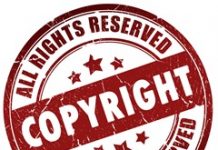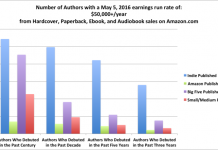 I received an email recently from an indie author whose work I reviewed on Smashwords, questioning a comment I made in the review about the ebook being priced fairly high ($7.99) for the sort of book it was. She had some reasons for setting the price at this level: she was basing it on what she thought a ‘real’ paper book would sell for, and she felt that the availability of a free sample meant that the reader could decide—and if they decided to commit to the novel, why not command a retail price?
I received an email recently from an indie author whose work I reviewed on Smashwords, questioning a comment I made in the review about the ebook being priced fairly high ($7.99) for the sort of book it was. She had some reasons for setting the price at this level: she was basing it on what she thought a ‘real’ paper book would sell for, and she felt that the availability of a free sample meant that the reader could decide—and if they decided to commit to the novel, why not command a retail price?
I wrote her back with my analysis, and here were some questions I used to guide it:
1) What would this book sell for in paper?
She thought the book would see for $14.99, making her $7.99 price a bargain. But is this true? Her book is a genre suspense novel by a newbie. It would not command a hardcover release, and trade paper is typically reserved for literary fiction. So, let’s say mass market paperback. We’re looking at about $6-8 for a new release IN PAPER. Let’s be generous and round up to $7 then.
2) What ‘paper’ costs are not an issue?
The comment I hear most often from those in the publishing industry is that paper costs account for less than we think they do—about $2 per book. Fine. Let’s accept this number and knock $2 off her ebook price since she is not dealing with printing, warehousing, shipping and other related costs. We’re down to $5 now.
3) What other costs would a ‘real’ book have that a self-published book does not?
Well, there is the fee to the agent. And then there is the publisher’s cut, which pays for the editor, art department, marketing department etc. The typical percentage breakdown is 10% to the author which would only make the book worth about 60 cents. Let’s flip it and knock off the 10% instead as the publisher’s cut. This will take off just under $2. We’re down to $3 now.
4) What are similar books selling for?
And sure enough, a little market research reveals that most indie-published books are selling in the range of $0.99-2.99 making her book, indeed, over-priced. By nature of being an ebook and not a paper one, and not having the same overhead as a traditionally published one, the book is automatically worth about $4 less—and that’s without even considering the qualitative aspects of how good a book it is.
This may be a tough truth for some people. But you simply can’t expect readers to pay a paper book price when they aren’t getting paper, or a publisher-level price when the book has not benefited from the value a publisher adds to the finished product. I am not saying that an indie ebook is by its nature inferior as a reading experience—I am calculating the price strictly on numbers here, before the quality is even considered. It’s simply not worth as much because it isn’t bearing the same production costs.


































If I were the rank the importance of those four factors it would go like this:
1) 5%
2) 1%
3) 1%
4) 93%
Basically the price of the competing book are deciding.
While I do agree with you that $7.99 is a high price for an ebook (of any kind, honestly), I think part of your argument is flawed. A self-published book has marketing, design and other overhead costs associated with it, just like a “real” book. The difference is, they’re paid by the author, not a publishing company. You can’t immediately discount $2 from the price on that account, because chances are, the author is spending relatively more per book on those costs than a streamlined publisher would. The entire argument for self-publishing is that you bear the extra costs, but reap the rewards for a job well done. Being relegated to $3 (or worse yet, $0.60) just because you had an entrepreneurial spirit is a bit silly, don’t you think?
That said, the work has to be able to stand on its own, which makes this an all-or-nothing game. I think $7.99 is a lot to pay in most cases, and I think your arguments are all well-founded, except that one point, which veers into excuse-making rather than reason 🙂
What other costs would a ‘real’ book have that a self-published book does not?
I take issue with this. First of all, Indie books are real books and an ebook is also a real book to some extent. Many Indie authors do, in fact, pay for freelance editing, and cover design, and interior layout, and marketing, not to mention software, etc. So when an Indie author sets the sale price for their book, they need to take that overhead into consideration just like a ‘real’ publisher would. The only things that can be safely deducted from an ebook, overhead wise, are printing costs and warehousing/transportation costs. eBooks have editorial costs, cover design costs, layout costs, epub conversion costs in some cases, marketing costs, copyright registration costs, etc.
Of course, the average reader doesn’t know that; they wrongly assume, like you did, that because it’s on Smashwords, that the book doesn’t have the ‘production value’ of a traditionally published book, which is just not true in many cases.
Self-published authors should price competitively with what is selling in their genre based on content, or rather, length. A Sci-fi novella at 40k words should be priced less than a full length Sci-fi novel and so forth while taking into consideration the production costs associated with work. I do agree that an ebook should be priced slightly less than a paper book, of course, but you cannot use mass-market paperback costs for comparison because Indie publishers use POD predominantly, which is a trade paper size and doesn not allow for the heavy discounting a traditional publisher gets with offset printing.
So as for pricing, it’s a lot more complicated than saying: Indie books average this price so anything above that is too high.
Joanna,
“It’s simply not worth as much because it isn’t bearing the same production costs.”
There is a lot of economic fallacy contained in this statement and other parts of the article.
Let’s say that you have a book with a $100 unit price. Is the price too high? The only way to judge that is to ask yourself what effect a lower price will be likely to have.
It is not cost that most directly counts, but profits. If some lower price will result in an increase in total net sales revenue that exceeds the increase in costs that the extra unit production incurs, then the price should be lowered.
Note that only future costs are price-determining. If you’re trying to sell an existing stock of a book, your past printing cost is a sunk cost, and of no economic significance, only an historical accounting one.
As a reader, the difference between a free book and a $2.99 book pales in comparison to the opportunity cost of the time I will spend reading it and the value that I will derive from reading it. I prefer a non-free book if I judge that it will have a higher probability of enjoyment.
Regards, Don
Definitely fall in line with similar pricing for similar genre and similar sales channels. There is something to be said for “overpricing” as well — if something is too cheap is it even worth it? For this reason, 99¢ can be counter-productive.
I’d be inclined to view $4.99 as the regular bottom — which leaves room for occasional special offers. Assuming the author has a few titles, then you can charge a modest premium for the latest title, and “loss leader” pricing for the oldest title(s). Think $1.99 — $4.99 — $6.99 as that model.
And be sure to have credible samples — the first chapter or two — available as widely as possible. And, of course, promote the title, have a strong cover and compelling “sales copy”.
In this case, I knew the author had not paid for an editor. Firstly, there were some issues an editor would have caught (for example, several turns of phrase that gave her away as a non-native speaker of English) and secondly because she told me when I asked. So Cheryl, I was not ‘wrongly assuming’ and I don’t think I am being unfair to indie authors when I say that a genre title by a new author working alone should not command the same (or, comparing to some books I’ve bought, a higher) price as a release by a best-selling author. I told *this* author that I thought she really had to think about what other similar books were going for; most genre titles by lone wolf authors on Smashwords are going for $0.99 to $2.99 and there is a reason for that. I outlined some of the reasons above.
I have worked as a writer, for pay, just to clarify that once and for all 🙂 Many comments here seem to assume I am speaking out of the air here and don’t know what I’m talking about, but I do have some background in publishing and know about what some of the issues are 🙂
I’ve seen a lot of analysis about e-book pricing based on cost-of-printing savings, but pricing is determined by supply and demand, not production costs. So there are two things to think about:
1. If readers find it easier or more enjoyable to buy and/or read digitally, then e-book costs should rise.
2. If the ease of writing and distributing an e-books means more the number of e-book titles are offered, Then e-book costs should lower.
I think the second point is definitely true (for distribution more so than writing), but the 1st point is trickier. Some people will prefer reading digitally but many will still prefer reading on paper.
I’m starting to think that e-book prices will ultimately drop only slightly, but physical book prices will begin rising as authors increasingly opt for self-publishing, dropping the p-book supply levels.
First, I have to quibble with the term “indie” for a self-published author. For many years in publishing, an independent/indie was a small publisher, not owned by a conglomerate. An indie author wrote for one of these small publishers.
A self-published author is self-published, not an indie author, and a subsidy publisher, vanity publisher, or printer is not an indie press.
I also don’t think it is a reviewer’s job to say whether a book is too expensive. It has never been a reviewer’s job.
Quote the price with the rest of the book information and let the reader decide whether the book is worth it or not.
As to price, if a self-published author wants to have her book available at all the standard distribution sites, she will have to jack up the price because many of the big sites will automatically give a price reduction from the listed price, and, in most cases, she will receive the percentage off the reduced price, not the listed price.
Your article did not mention that you found editorial issues in the work, and editorial issues have no bearing on price, not from a reviewer standpoint. I find editorial issues in mainstream books too, so by that logic they should be cheaper as well. I took issue with your wording, not your facts, although you didn’t really list “all” the facts. I also didn’t question your position of authority on the subject. You made a broad sweeping statement in your article basically saying that Self-published books are not of the same production quality as “real” books. And while that might be true in some cases, that statement cannot be made for Self-published books in general. This is just perpetuating the stigma that all self-published books are lacking, and that is just not true. Many of the self-published books I have reviewed have had stellar production quality, some even better than traditionally published paperbacks with respect to cover, layout, and printing quality.
As far as the term Indie, Indie is short for Independent, meaning Independent from the tradtional publishing business model. Many self-published authors have established small presses and function exactly like any other small press independent of the NYC publishing dynamic. Those who function outside of the mainstream publishing system are Independent. To quibble over the term is silly considering its definition. However, vanity or subsity or whatever you want to call places like Authorhouse, are a seperate thing entirely. They are an author service provider, and an Independent author contracts them for various project management services. Just as a tradtional publisher will contract out for cover design and printing and so forth.
I quibble with the term “indie” because it has been used for many years to mean one thing, and suddenly, it should not mean something else.
If you are a self-published author, say it loud and proud, but do not call yourself an indie author when you aren’t being published by an indie publisher.
An excellent post Alexander.
The only problem with low pricing not being taken seriously is the comparison issue. If all books were $2 then 99c would not be an issue.
I agree with this view fully.
Absolutely 100%
I’m a fan of Smashwords. For me, a first novel by an unknown author is going to need to be priced at $3.99 or less to get me to consider it.
For novels published by the big trade publishers, most authors are lucky to get an advance of even $1 per copy, and most will never see a penny after that advance. According to Money Magazine, John Grisham got $3.56 (after an assumed 15% agent commission) per copy for The Associate in hardcover, and we can presume less than that for paperback copies.
For Smashwords, a $3.99 selling price with an 85% commission rate gives the author about $3.39 royalty per copy. That looks like a big-league royalty rate to me.
I’m currently reading a Smashwords novel that was “You set the price” when I got it. I could have had it for free, but based on looking over the preview I chose to pay $2.99 for it, and so far I think that was a fair price. But the author is now asking $9.99 for it, and I simply can’t see that price as anything like realistic.
For authors with a reasonably proven track record on Smashwords, or at least a lot of rave reviews, I’d consider up to maybe $6.99 for a standard novel. But that’s really, really pushing it for me.
Doug:
The royalty rate shouldn’t be compared only basing on the commission rate per copy, but also considering how many copies are sold. And while the paperback sells in 1000s or 10000s copies, the indie eBook sells around 10s or 100s copies, which means 1000*1$ (1000$) > 100*3.39$ (339$).